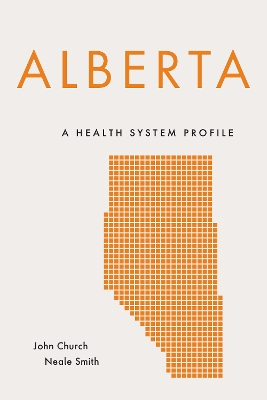Alberta
 portes grátis
portes grátis
Alberta
A Health System Profile
Smith, Neale; Church, John
University of Toronto Press
03/2022
286
Mole
Inglês
9781487525163
15 a 20 dias
420
Descrição não disponível.
List of Figures, Tables, and Boxes
Series Editor's Foreword
Preface and Acknowledgements
List of Acronyms
Chapter 1: Introduction and Overview
1.1 Geography and Demography
1.2 Political Context
1.3 Alberta's Economy
1.4 Health Status
1.5 Conclusion
Chapter 2: Organization and Regulation
2.1 Overview of the health system
2.1.1 Early History
2.1.2 Health System Restructuring 1993-2007
2.2 Organization of the Provincial Health System
2.2.1 Alberta Health
2.2.2 Alberta Health Services
2.2.3 Contractors
2.3 Health System Planning
2.4 Coverage and Benefits
2.4.1 Eligibility for Benefits
2.5 Regulation
2.5.1 Providers
2.5.2 Hospitals
2.5.3 Continuing Care
2.5.4 Public Health
2.5.5 Diagnostic Imaging
2.5.6 Prescription Drugs
2.5.7 Patient Health Information
2.6 Patients
2.7 Health Research
2.8 Summary
Chapter 3: Health Expenditures and Financing
3.1 Health System Financing Flows
3.2 Health Expenditures and Trends
3.2.1 Payment Methods
3.2.2 Private and Out-of-Pocket Spending
3.3 Public Revenues
3.3.1 Provincial Own-Source Revenues
3.3.2 Federal Transfers
3.4 Summary
Chapter 4: Physical Infrastructure
4.1 Hospitals and other treatment Facilities
4.1.1 Size and Geography
4.1.2 Ownership
4.1.3 Specialization
4.1.4 Structural condition
4.2 Long Term (Continuing Care) facilities
4.2.1 Size and Geography
4.2.2 Ownership
4.2.3 Specialization
4.2.4 Age and Design
4.3 Diagnostic Imaging and Laboratory (DIAL) services
4.3.1 Laboratory Services
4.3.2 Diagnostic Imaging
4.4 Public Health Facilities and Community Health Centres
4.5 Information and Communications Technology Infrastructure
4.5.1 Electronic Health Records (EHRs) and Electronic Medical Records (EMRs)
4.5.2 Telehealth
4.6 Health Research Infrastructure
4.7 Summary
Chapter 5: Health Workforce
5.1 Main Workforce Challenges
5.2 Physicians
5.3 Regulated Nurses
5.4 Other Health Care Providers
5.4.1 Complimentary Health Care Providers
5.4.2 Pharmaceutical Workforce
5.4.3 Emergency Medical Workforce
5.4.4 Diagnostic Workforce
5.4.5 Rehabilitation Workforce
5.4.6 Dental Workforce
5.4.7 Eye Care Workforce
5.4.8 Public Health Workforce
5.5 Health Human Resource Planning and Collective Bargaining
5.5.1 HHR Planning
5.5.2 Collective Bargaining
5.6 Conclusion
Chapter 6: Services and Programs Provided in Alberta's Health System
6.1 Public Health Services
6.1.1 Public Health Nursing and Communicable Disease Control
6.1.2 Environment Health Services
6.1.3 Health Promotion
6.2 Primary Care
6.3 Acute (secondary, tertiary) care including emergency services
6.3.1 Emergency Services
6.4 Diagnostic Imaging and Laboratory Services
6.5 Long-term and Continuing Care services
6.5.1 Long-term care (LTC)
6.5.2 Home and Community Care
6.6 Prescription drugs
6.7 Occupation Health Services and Rehabilitation Care
6.7.1 Occupational Health and Safety
6.7.2 Rehabilitation Care
6.8 Mental Health Care and Addictions Services
6.9 Dental Health Care Services
6.10 Complementary and Alternative Medicines and Care
6.11 Targeted Services for Indigenous and/or Minority Groups
6.12 Palliative (end-of-life) care
6.12.1 Palliative Care
6.12.2 Medical Assistance in Dying
6.13 Summary
Chapter 7: Recent Health Reforms
7.1 Alberta Health Services
7.2 Strategic Clinical Networks
7.3 Primary Care
7.4 Wait Times
7.5 Patient Safety
7.6 Patient Advocacy
7.7 Health Research
7.8 Conclusion
Chapter 8: Assessing Alberta's Health Care System
8.1 Stated Objectives of the Health System
8.2 Financial Protection and Equity
8.3 Health System and Service Outcomes
8.3.1 Access to Care
8.3.2 Wait Times
8.3.3 Patient Safety
8.4 User Experience and Satisfaction
8.4.1 Access
8.4.2 Satisfaction
8.4.3 Continuity of Care
8.5 Efficiency (technical and allocative)
8.5.1 Financial Costs
8.5.2 Utilization
8.5.3 Public Health
8.5.4 Integration
8.5.5 Resource Allocation
8.5.6 Mortality
8.6 Accountability
8.7 Information, Performance Measurement and Quality Assurance
8.8 Conclusion
Chapter 9: Conclusion
9.1 The Economy and People
9.2 Health Care Costs
9.3 Health System Governance
9.4 Health Workforce
9.5 Professionalism
9.6 Infrastructure and Services
9.7 Performance Measurement
9.8 Performance Outcomes
9.9 Final Thoughts
Afterwards
References
Index
Series Editor's Foreword
Preface and Acknowledgements
List of Acronyms
Chapter 1: Introduction and Overview
1.1 Geography and Demography
1.2 Political Context
1.3 Alberta's Economy
1.4 Health Status
1.5 Conclusion
Chapter 2: Organization and Regulation
2.1 Overview of the health system
2.1.1 Early History
2.1.2 Health System Restructuring 1993-2007
2.2 Organization of the Provincial Health System
2.2.1 Alberta Health
2.2.2 Alberta Health Services
2.2.3 Contractors
2.3 Health System Planning
2.4 Coverage and Benefits
2.4.1 Eligibility for Benefits
2.5 Regulation
2.5.1 Providers
2.5.2 Hospitals
2.5.3 Continuing Care
2.5.4 Public Health
2.5.5 Diagnostic Imaging
2.5.6 Prescription Drugs
2.5.7 Patient Health Information
2.6 Patients
2.7 Health Research
2.8 Summary
Chapter 3: Health Expenditures and Financing
3.1 Health System Financing Flows
3.2 Health Expenditures and Trends
3.2.1 Payment Methods
3.2.2 Private and Out-of-Pocket Spending
3.3 Public Revenues
3.3.1 Provincial Own-Source Revenues
3.3.2 Federal Transfers
3.4 Summary
Chapter 4: Physical Infrastructure
4.1 Hospitals and other treatment Facilities
4.1.1 Size and Geography
4.1.2 Ownership
4.1.3 Specialization
4.1.4 Structural condition
4.2 Long Term (Continuing Care) facilities
4.2.1 Size and Geography
4.2.2 Ownership
4.2.3 Specialization
4.2.4 Age and Design
4.3 Diagnostic Imaging and Laboratory (DIAL) services
4.3.1 Laboratory Services
4.3.2 Diagnostic Imaging
4.4 Public Health Facilities and Community Health Centres
4.5 Information and Communications Technology Infrastructure
4.5.1 Electronic Health Records (EHRs) and Electronic Medical Records (EMRs)
4.5.2 Telehealth
4.6 Health Research Infrastructure
4.7 Summary
Chapter 5: Health Workforce
5.1 Main Workforce Challenges
5.2 Physicians
5.3 Regulated Nurses
5.4 Other Health Care Providers
5.4.1 Complimentary Health Care Providers
5.4.2 Pharmaceutical Workforce
5.4.3 Emergency Medical Workforce
5.4.4 Diagnostic Workforce
5.4.5 Rehabilitation Workforce
5.4.6 Dental Workforce
5.4.7 Eye Care Workforce
5.4.8 Public Health Workforce
5.5 Health Human Resource Planning and Collective Bargaining
5.5.1 HHR Planning
5.5.2 Collective Bargaining
5.6 Conclusion
Chapter 6: Services and Programs Provided in Alberta's Health System
6.1 Public Health Services
6.1.1 Public Health Nursing and Communicable Disease Control
6.1.2 Environment Health Services
6.1.3 Health Promotion
6.2 Primary Care
6.3 Acute (secondary, tertiary) care including emergency services
6.3.1 Emergency Services
6.4 Diagnostic Imaging and Laboratory Services
6.5 Long-term and Continuing Care services
6.5.1 Long-term care (LTC)
6.5.2 Home and Community Care
6.6 Prescription drugs
6.7 Occupation Health Services and Rehabilitation Care
6.7.1 Occupational Health and Safety
6.7.2 Rehabilitation Care
6.8 Mental Health Care and Addictions Services
6.9 Dental Health Care Services
6.10 Complementary and Alternative Medicines and Care
6.11 Targeted Services for Indigenous and/or Minority Groups
6.12 Palliative (end-of-life) care
6.12.1 Palliative Care
6.12.2 Medical Assistance in Dying
6.13 Summary
Chapter 7: Recent Health Reforms
7.1 Alberta Health Services
7.2 Strategic Clinical Networks
7.3 Primary Care
7.4 Wait Times
7.5 Patient Safety
7.6 Patient Advocacy
7.7 Health Research
7.8 Conclusion
Chapter 8: Assessing Alberta's Health Care System
8.1 Stated Objectives of the Health System
8.2 Financial Protection and Equity
8.3 Health System and Service Outcomes
8.3.1 Access to Care
8.3.2 Wait Times
8.3.3 Patient Safety
8.4 User Experience and Satisfaction
8.4.1 Access
8.4.2 Satisfaction
8.4.3 Continuity of Care
8.5 Efficiency (technical and allocative)
8.5.1 Financial Costs
8.5.2 Utilization
8.5.3 Public Health
8.5.4 Integration
8.5.5 Resource Allocation
8.5.6 Mortality
8.6 Accountability
8.7 Information, Performance Measurement and Quality Assurance
8.8 Conclusion
Chapter 9: Conclusion
9.1 The Economy and People
9.2 Health Care Costs
9.3 Health System Governance
9.4 Health Workforce
9.5 Professionalism
9.6 Infrastructure and Services
9.7 Performance Measurement
9.8 Performance Outcomes
9.9 Final Thoughts
Afterwards
References
Index
Este título pertence ao(s) assunto(s) indicados(s). Para ver outros títulos clique no assunto desejado.
health policy; health policy research; health care; Alberta; Ralph Klein; Jason Kenney; Alberta Health Services; AHS
List of Figures, Tables, and Boxes
Series Editor's Foreword
Preface and Acknowledgements
List of Acronyms
Chapter 1: Introduction and Overview
1.1 Geography and Demography
1.2 Political Context
1.3 Alberta's Economy
1.4 Health Status
1.5 Conclusion
Chapter 2: Organization and Regulation
2.1 Overview of the health system
2.1.1 Early History
2.1.2 Health System Restructuring 1993-2007
2.2 Organization of the Provincial Health System
2.2.1 Alberta Health
2.2.2 Alberta Health Services
2.2.3 Contractors
2.3 Health System Planning
2.4 Coverage and Benefits
2.4.1 Eligibility for Benefits
2.5 Regulation
2.5.1 Providers
2.5.2 Hospitals
2.5.3 Continuing Care
2.5.4 Public Health
2.5.5 Diagnostic Imaging
2.5.6 Prescription Drugs
2.5.7 Patient Health Information
2.6 Patients
2.7 Health Research
2.8 Summary
Chapter 3: Health Expenditures and Financing
3.1 Health System Financing Flows
3.2 Health Expenditures and Trends
3.2.1 Payment Methods
3.2.2 Private and Out-of-Pocket Spending
3.3 Public Revenues
3.3.1 Provincial Own-Source Revenues
3.3.2 Federal Transfers
3.4 Summary
Chapter 4: Physical Infrastructure
4.1 Hospitals and other treatment Facilities
4.1.1 Size and Geography
4.1.2 Ownership
4.1.3 Specialization
4.1.4 Structural condition
4.2 Long Term (Continuing Care) facilities
4.2.1 Size and Geography
4.2.2 Ownership
4.2.3 Specialization
4.2.4 Age and Design
4.3 Diagnostic Imaging and Laboratory (DIAL) services
4.3.1 Laboratory Services
4.3.2 Diagnostic Imaging
4.4 Public Health Facilities and Community Health Centres
4.5 Information and Communications Technology Infrastructure
4.5.1 Electronic Health Records (EHRs) and Electronic Medical Records (EMRs)
4.5.2 Telehealth
4.6 Health Research Infrastructure
4.7 Summary
Chapter 5: Health Workforce
5.1 Main Workforce Challenges
5.2 Physicians
5.3 Regulated Nurses
5.4 Other Health Care Providers
5.4.1 Complimentary Health Care Providers
5.4.2 Pharmaceutical Workforce
5.4.3 Emergency Medical Workforce
5.4.4 Diagnostic Workforce
5.4.5 Rehabilitation Workforce
5.4.6 Dental Workforce
5.4.7 Eye Care Workforce
5.4.8 Public Health Workforce
5.5 Health Human Resource Planning and Collective Bargaining
5.5.1 HHR Planning
5.5.2 Collective Bargaining
5.6 Conclusion
Chapter 6: Services and Programs Provided in Alberta's Health System
6.1 Public Health Services
6.1.1 Public Health Nursing and Communicable Disease Control
6.1.2 Environment Health Services
6.1.3 Health Promotion
6.2 Primary Care
6.3 Acute (secondary, tertiary) care including emergency services
6.3.1 Emergency Services
6.4 Diagnostic Imaging and Laboratory Services
6.5 Long-term and Continuing Care services
6.5.1 Long-term care (LTC)
6.5.2 Home and Community Care
6.6 Prescription drugs
6.7 Occupation Health Services and Rehabilitation Care
6.7.1 Occupational Health and Safety
6.7.2 Rehabilitation Care
6.8 Mental Health Care and Addictions Services
6.9 Dental Health Care Services
6.10 Complementary and Alternative Medicines and Care
6.11 Targeted Services for Indigenous and/or Minority Groups
6.12 Palliative (end-of-life) care
6.12.1 Palliative Care
6.12.2 Medical Assistance in Dying
6.13 Summary
Chapter 7: Recent Health Reforms
7.1 Alberta Health Services
7.2 Strategic Clinical Networks
7.3 Primary Care
7.4 Wait Times
7.5 Patient Safety
7.6 Patient Advocacy
7.7 Health Research
7.8 Conclusion
Chapter 8: Assessing Alberta's Health Care System
8.1 Stated Objectives of the Health System
8.2 Financial Protection and Equity
8.3 Health System and Service Outcomes
8.3.1 Access to Care
8.3.2 Wait Times
8.3.3 Patient Safety
8.4 User Experience and Satisfaction
8.4.1 Access
8.4.2 Satisfaction
8.4.3 Continuity of Care
8.5 Efficiency (technical and allocative)
8.5.1 Financial Costs
8.5.2 Utilization
8.5.3 Public Health
8.5.4 Integration
8.5.5 Resource Allocation
8.5.6 Mortality
8.6 Accountability
8.7 Information, Performance Measurement and Quality Assurance
8.8 Conclusion
Chapter 9: Conclusion
9.1 The Economy and People
9.2 Health Care Costs
9.3 Health System Governance
9.4 Health Workforce
9.5 Professionalism
9.6 Infrastructure and Services
9.7 Performance Measurement
9.8 Performance Outcomes
9.9 Final Thoughts
Afterwards
References
Index
Series Editor's Foreword
Preface and Acknowledgements
List of Acronyms
Chapter 1: Introduction and Overview
1.1 Geography and Demography
1.2 Political Context
1.3 Alberta's Economy
1.4 Health Status
1.5 Conclusion
Chapter 2: Organization and Regulation
2.1 Overview of the health system
2.1.1 Early History
2.1.2 Health System Restructuring 1993-2007
2.2 Organization of the Provincial Health System
2.2.1 Alberta Health
2.2.2 Alberta Health Services
2.2.3 Contractors
2.3 Health System Planning
2.4 Coverage and Benefits
2.4.1 Eligibility for Benefits
2.5 Regulation
2.5.1 Providers
2.5.2 Hospitals
2.5.3 Continuing Care
2.5.4 Public Health
2.5.5 Diagnostic Imaging
2.5.6 Prescription Drugs
2.5.7 Patient Health Information
2.6 Patients
2.7 Health Research
2.8 Summary
Chapter 3: Health Expenditures and Financing
3.1 Health System Financing Flows
3.2 Health Expenditures and Trends
3.2.1 Payment Methods
3.2.2 Private and Out-of-Pocket Spending
3.3 Public Revenues
3.3.1 Provincial Own-Source Revenues
3.3.2 Federal Transfers
3.4 Summary
Chapter 4: Physical Infrastructure
4.1 Hospitals and other treatment Facilities
4.1.1 Size and Geography
4.1.2 Ownership
4.1.3 Specialization
4.1.4 Structural condition
4.2 Long Term (Continuing Care) facilities
4.2.1 Size and Geography
4.2.2 Ownership
4.2.3 Specialization
4.2.4 Age and Design
4.3 Diagnostic Imaging and Laboratory (DIAL) services
4.3.1 Laboratory Services
4.3.2 Diagnostic Imaging
4.4 Public Health Facilities and Community Health Centres
4.5 Information and Communications Technology Infrastructure
4.5.1 Electronic Health Records (EHRs) and Electronic Medical Records (EMRs)
4.5.2 Telehealth
4.6 Health Research Infrastructure
4.7 Summary
Chapter 5: Health Workforce
5.1 Main Workforce Challenges
5.2 Physicians
5.3 Regulated Nurses
5.4 Other Health Care Providers
5.4.1 Complimentary Health Care Providers
5.4.2 Pharmaceutical Workforce
5.4.3 Emergency Medical Workforce
5.4.4 Diagnostic Workforce
5.4.5 Rehabilitation Workforce
5.4.6 Dental Workforce
5.4.7 Eye Care Workforce
5.4.8 Public Health Workforce
5.5 Health Human Resource Planning and Collective Bargaining
5.5.1 HHR Planning
5.5.2 Collective Bargaining
5.6 Conclusion
Chapter 6: Services and Programs Provided in Alberta's Health System
6.1 Public Health Services
6.1.1 Public Health Nursing and Communicable Disease Control
6.1.2 Environment Health Services
6.1.3 Health Promotion
6.2 Primary Care
6.3 Acute (secondary, tertiary) care including emergency services
6.3.1 Emergency Services
6.4 Diagnostic Imaging and Laboratory Services
6.5 Long-term and Continuing Care services
6.5.1 Long-term care (LTC)
6.5.2 Home and Community Care
6.6 Prescription drugs
6.7 Occupation Health Services and Rehabilitation Care
6.7.1 Occupational Health and Safety
6.7.2 Rehabilitation Care
6.8 Mental Health Care and Addictions Services
6.9 Dental Health Care Services
6.10 Complementary and Alternative Medicines and Care
6.11 Targeted Services for Indigenous and/or Minority Groups
6.12 Palliative (end-of-life) care
6.12.1 Palliative Care
6.12.2 Medical Assistance in Dying
6.13 Summary
Chapter 7: Recent Health Reforms
7.1 Alberta Health Services
7.2 Strategic Clinical Networks
7.3 Primary Care
7.4 Wait Times
7.5 Patient Safety
7.6 Patient Advocacy
7.7 Health Research
7.8 Conclusion
Chapter 8: Assessing Alberta's Health Care System
8.1 Stated Objectives of the Health System
8.2 Financial Protection and Equity
8.3 Health System and Service Outcomes
8.3.1 Access to Care
8.3.2 Wait Times
8.3.3 Patient Safety
8.4 User Experience and Satisfaction
8.4.1 Access
8.4.2 Satisfaction
8.4.3 Continuity of Care
8.5 Efficiency (technical and allocative)
8.5.1 Financial Costs
8.5.2 Utilization
8.5.3 Public Health
8.5.4 Integration
8.5.5 Resource Allocation
8.5.6 Mortality
8.6 Accountability
8.7 Information, Performance Measurement and Quality Assurance
8.8 Conclusion
Chapter 9: Conclusion
9.1 The Economy and People
9.2 Health Care Costs
9.3 Health System Governance
9.4 Health Workforce
9.5 Professionalism
9.6 Infrastructure and Services
9.7 Performance Measurement
9.8 Performance Outcomes
9.9 Final Thoughts
Afterwards
References
Index
Este título pertence ao(s) assunto(s) indicados(s). Para ver outros títulos clique no assunto desejado.







